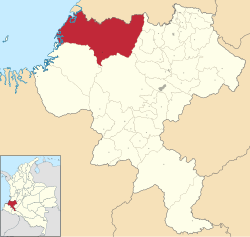López de Micay
This article needs additional citations for verification. (March 2009) |
López de Micay | |
|---|---|
Municipality and town | |
 View of López de Micay | |
 Location of the municipality and town of López de Micay in the Cauca Department of Colombia. | |
| Country | |
| Department | Cauca Department |
| Population (Census 2018[1]) | |
| • Total | 15,154 |
| Time zone | UTC-5 (Colombia Standard Time) |
| Climate | Af |
López de Micay (Spanish pronunciation: [ˈlopes ðe ˈmikaj]) is a town and municipality in the Cauca Department, Colombia. It is located on the Pacific Coast of the Cauca Department in the Naya Region on the foothills of the Colombian Western Cordillera. It is located 84 km from the departmental capital, Popayán.
History[edit]
The current municipality of López de Micay was founded as a town in 1888 by Pancracio Riascos, Facundo Riascos and Luciano Alomía. Before being established as a municipality, it had several names, among them Arrieros del Micay, possibly due to its proximity to the El Chambón mining center, which connected this territory with Popayán along the road called Los Arrieros. Likewise, it has had several municipal seats, such as San José del Trapiche and San Francisco del Naya (today a district belonging to Buenaventura, Valle del Cauca). In 1911 the District of Zaragoza was created as part of the Province of Micay. Finally, in 1915 the settlement of Zaragoza was moved to the place now occupied by the town centre. The name results from the conjunction of the indigenous name given to the river and the posthumous tribute paid to General José Hilario López, who in 1851 ordered the liberation of the slaves. Currently, the municipality is called López de Micay and its urban center is called San Miguel de Micay. [2]
Geography[edit]
The municipality of López de Micay limits to the north with Buenaventura, to the south with Timbiquí and El Tambo, Cauca, to the east with Buenos Aires, Cauca, Suárez, Cauca and Morales, Cauca, and to the west with the Pacific Ocean. In its territorial conformation, two different physiographic zones are identified: the coastal zone and the Western Cordillera. The first includes a wide strip parallel to the coastline, influenced by the action of tides and river waters, and the second is located on the western side of the Western Cordillera, formed by a series of broken and steep reliefs. The territories that make up the municipality are characterized by the tendency to floods, avalanches, landslides and earthquakes.[2] The main rivers, with their most representative tributaries and estuaries, are:
- Micay River Tributaries: Jolí, Chuare, Siguí, Gualala, Santa Barbara, Isla de Gallo, Iguana, Murciélago, Claudio, La Laguna, El Chachajo, El Trapiche, Arenal, Casa Vieja, Platanal and the streams of Hercilio, Tambor, Tambito and Yarumal.[2]
- Naya River Tributaries: Agua Clara, Dos Quebrada, San Bartolo, Las Pavas, San Francisco, la Puerquera, La Sierpe, Tigre, Aurora and Guaduatito.[2]
Climate[edit]
The Colombian meteorological service IDEAM reports an average annual precipitation of 12,892.4 mm (507.57 in), potentially making it the wettest inhabited place in the world;[3] however, some other sources state a lower average of 10,191 mm (401.2 in), which is below that of places in Meghalaya,[4] while some other sources state a higher average of approximately 16,000 mm (630 in) which would definitely make it the wettest place in the world.[5] It is one of the wettest places on the Earth, with at least some amount of rain falling almost every day, with frequent downpours and torrential rain that causes flash flooding.
López de Micay has an extremely wet tropical rainforest climate (Köppen Af). The average temperature is 26.9 °C (80.4 °F).
| Month | Jan | Feb | Mar | Apr | May | Jun | Jul | Aug | Sep | Oct | Nov | Dec | Year |
|---|---|---|---|---|---|---|---|---|---|---|---|---|---|
| Mean daily maximum °C (°F) | 31.3 (88.3) |
31.9 (89.4) |
32.1 (89.8) |
31.7 (89.1) |
31.6 (88.9) |
31.5 (88.7) |
32.0 (89.6) |
32.0 (89.6) |
31.7 (89.1) |
30.8 (87.4) |
30.6 (87.1) |
30.9 (87.6) |
31.5 (88.7) |
| Daily mean °C (°F) | 26.8 (80.2) |
27.1 (80.8) |
27.2 (81.0) |
27.1 (80.8) |
27.1 (80.8) |
26.8 (80.2) |
26.9 (80.4) |
27.0 (80.6) |
27.0 (80.6) |
26.7 (80.1) |
26.5 (79.7) |
26.5 (79.7) |
26.9 (80.4) |
| Mean daily minimum °C (°F) | 22.9 (73.2) |
22.3 (72.1) |
22.4 (72.3) |
22.6 (72.7) |
22.7 (72.9) |
22.2 (72.0) |
21.8 (71.2) |
22.0 (71.6) |
22.3 (72.1) |
22.6 (72.7) |
22.5 (72.5) |
22.2 (72.0) |
22.4 (72.3) |
| Average rainfall mm (inches) | 940.3 (37.02) |
804.4 (31.67) |
812.9 (32.00) |
1,399 (55.1) |
1,556.1 (61.26) |
1,301.6 (51.24) |
997.9 (39.29) |
935.5 (36.83) |
1,931 (76.0) |
1,641.9 (64.64) |
1,660.2 (65.36) |
2,011.3 (79.19) |
15,992.1 (629.6) |
| Average rainy days (≥ 1 mm) | 26 | 23 | 24 | 25 | 28 | 27 | 26 | 27 | 27 | 28 | 27 | 27 | 315 |
| Source: [6] [7] | |||||||||||||
References[edit]
- ^ "Censo Nacional de Población y Vivienda 2018" (in Spanish). DANE. Retrieved 23 April 2020.
- ^ a b c d Defensoría del Pueblo (2013). Informe Estructural Situación de Riesgo por Conflicto Armado en la Costa Pacífica Caucana Municipios de Guapi, Timbiquí y López de Micay (PDF). Bogotá: www.defensoria.org.co.
- ^ Burt, Christopher C. (2013-03-18). "New Wettest Place on Earth Discovered?". Weather Underground. Archived from the original on 2014-10-31. Retrieved 2014-10-30.
- ^ "Climate: López de Micay". climate-data.org. Retrieved June 4, 2018.
- ^ "Archived copy". Archived from the original on 2016-08-15. Retrieved 2019-11-06.
{{cite web}}: CS1 maint: archived copy as title (link) - ^ http://www.ideam.gov.co/documents/21021/553571/Promedios+Climatol%C3%B3gicos++1981+-+2010.xlsx/f28d0b07-1208-4a46-8ccf-bddd70fb4128
- ^ "Climate: López de Micay". Climate-Data.org. Retrieved May 3, 2018.
3°00′N 77°15′W / 3.000°N 77.250°W


